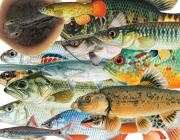March 2022 - COVID slowed us down significantly, but our collaborators researching genetics and otolith microchemistry of eels should soon be filing their final reports with us, and we then will file our final report on statewide eel sampling with Texas Parks and Wildlife. At the same time, with that funded project is ending, we've put together a plan to start a barebones capature, mark, recapture project focused below Longhorn Dam in Austin and nearby Colorado River tributaries where it appears there are currently many small, recently recruited eels. Knowing of those opened doors to opportunities to study of eels in Texas in new ways that can reveal much more detail about how the species functions in Gulf of Mexico rivers and how important Gulf of Mexico rivers are in sustaining the species. A couple of great new volunteers joined our lab to help with that. Holland Austin is out most every weekend fishing for eels, and has provided lots of very important data on local populations that is an amazing complement to our couple of years looking statewide for them with TPWD. More recently, Aidan Mabey, with over a decade conducting research on American Eel in the very successful Hudson Bay glass and elver monitoring program, and doing K-12 outreach work on eels, moved to Austin and joined our team to help spearhead the local mark/recapture work that we hope will be up and rolling by late spring 2022.
January 3, 2020 - The Atlantic published a great 15-minute video documentary on the elver fishery in Maine.
September 27, 2019 - Radiolab released a great podcast on eels.
September 17, 2019 - this project got some important publicity via a front page article in the Austin American Statesman newspaper.
May 13, 2019 - Our eel project's going quite well, in large part due to our close collaboration with the Rivers Study group of Texas Parks and Wildlife (TPWD).
We slightly surpassed our goal of 100 tissue samples for genetics. All of Texas' major river basins except the Neches and Trinity are represented and the tissues are all now with the doctoral student doing genetic analyses at Université Laval in Quebec. We know that at least Louisiana Department of Wildlife and Fisheries, colleagues in Costa Rica, and others in the Caribbean, have also contributed tissues to the same study. We extracted otoliths from all of our specimens for microchemistry (informative regarding timing of movements of individuals between salt- and freshwater) and ageing in Dr. Ben Walther's lab at Texas A&M University Corpus Cristi.
That sample size was attained by extensive sampling, often at night, that threw virtually every type of gear at them that we could muster. In wadeable areas, trot lines and backpack electrofishing were most productive, especially when deployed in the vicinity of rip-rap and below dams, and TPWD took good numbers via boat-based electrofishing in larger habitats. Sixteen (ranging from 16.7 – 78.4 cm Standard Length) were found when a pump maintenance project de-watered a sump in the outflow channel of a sewage treatment plant.
That diverse sample includes all size classes from a presumed elver (15.1 cm SL) to what we presumed likely to be a downstream-migrant adult found dead on a beach and salvaged after only partial scavenging by birds. We did not target leptocephali larvae, and efforts to get glass eels and elvers were taken on by our collaborators at TPWD, deploying eel mops and fyke nets at scattered sites along the coast. So far, this effort has not produced any glass eels or elvers, but mops are still being deployed. As far as we know, nobody has ever documented glass eels in TX.
Our efforts to increase awareness about the species and our need for specimens produced many more (including historic) records of occurrences. These came from anglers and other private individuals, and from other researchers who incidentally took them while sampling for other species.
We’ve had some interesting detours and spinoffs along the way that pique our curiosity, and we’re starting to explore them a bit:
The remarkable paucity of records of leptocephali from the Gulf got us thinking more about their voyage from the Sargasso Sea to Texas. We’re hoping oceanographers far more knowledgeable about ocean currents and their histories than us might provide some insights. We also know some researchers have figured out how to predict timing and magnitude of arrival of Sargassum spp. to Gulf Coast beaches, and that work might also prove relevant to eels. In any case, given the distance and obvious complexity of that journey from the Sargasso, we wouldn’t be surprised if leptocephali make it to the Gulf and Texas only relatively rarely and sporadically, and anything that might help us anticipate where and when to expect glass eels to be heading up Texas rivers would be most welcome. Currently, any attempts to get samples of glass eels along the Texas coast remain pretty much a “shot in the dark.” However, given the importance of glass eel monitoring for assessment of recruitment throughout the rest of the species’ range, figuring out how to find and quantify them as they enter Gulf rivers is likely to be key for long-term monitoring and determining the status of the species here as well.
Maybe related in some way to ocean currents, in contrast to the rich archaeological record of eels in Europe and the eastern US/Canada, we’ve discovered that there are apparently no records of the species in the relatively rich and well-studied Texas archaeological record. So, we’re talking to regional archaeologists and hoping to take a closer look at the archeological data for evidence of eels. Could it be that their arrival to the Gulf has been relatively recent, and perhaps related to a change in ocean circulation between the Sargasso, Caribbean, and Gulf?

